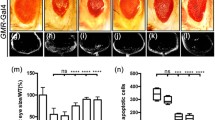Abstract
The present study was aimed to investigate whether or not cyclin-dependent kinases (CDKs) participate in different cascades leading to apoptosis. We examined the effects of two CDK inhibitors, olomoucine (OLM) and buty-rolactone-I (BL-I), on apoptosis induced in two kinds of Drosophila cell lines. Increases of caspase activity induced by actinomycin D, cycloheximide, H-7 or A23187 in a Drosophila neuronal cell line, ML-DmBG2-c2, and induced by excessive expression of a Drosophila cell death gene, reaper, in Drosophila S2 cells were suppressed by 24-h pretreatment of each CDK inhibitor. Concomitant with the suppression of the caspase activity, fragmentations of cells and DNA, representatives of apoptosis, were also inhibited. These results suggest that CDK(s) participates in progression of apoptosis. However, these effects of the CDK inhibitors were also observed even at lower doses which did not affect cell proliferation. Therefore, it was shown that apoptosis is not always related to cell cycle in Drosophila cells. It was also suggested that the target(s) of the CDK inhibitors locates upstream of caspase in the cascade(s) of apoptosis.
Similar content being viewed by others
References
Cooper GM. The Cell Cycle. In The Cell: A Molecular Approach. Washington, D.C. ASM Press, 1997; 589–593.
Tsujimoto Y. Role of Bcl-2 family proteins in apoptosis: Apoptosomes or mitochondria? Genes Cells1998; 3: 697–707.
LaCasse EC, Baird S, Korneluk RG, MacKenzie AE. The inhibitors of apoptosis (IAPs) and their emerging role in cancer. Oncogene1998; 17: 3247–3259.
Thomaidou D, Mione MC, Cavanagh JF, Parnavelas JG. Apoptosis and its relation to the cell cycle in the developing cerebral cortex. J Neurosci1997; 17: 1075–1085.
Shih SC, Stutman O. Cell cycle-dependent tumor necrosis factor apoptosis. Cancer Res1996; 56: 1591–1598.
Gil GG, Berns A, Brady HJ. A link between cell cycle and cell death: Bax and Bcl-2 modulate Cdk2 activation during thymocyte apoptosis. TIEMBO J1998; 17: 7209–7218.
Park DS, Morris EJ, Greene LA, Geller HM. G1/S cell cycle blockers and inhibitors of cyclin-dependent kinases suppress camptothecin-induced neuronal apoptosis. J Neurosci1997; 17: 1256–1270.
Park DS, Morris EJ, Stefanis L, et al. Multiple pathways of neuronal death induced by DNA-damaging agents, NGF deprivation, and oxidative stress. J Neurosci1998; 18: 830–840.
Maas JJ, Horstmann S, Borasio GD, Anneser JM, Shooter EM, Kahle PJ. Apoptosis of central and peripheral neurons can be prevented with cyclin-dependent kinase/mitogen-activated protein kinase inhibitors. J Neurochem1998; 70: 1401–1410.
Lu Y, Yamagishi N, Yagi T, Takebe H. Mutated p21 (WAF1/CIP1/SDI1) lacking CDK-inhibitory activity fails to prevent apoptosis in human colorectal carcinoma cells. Oncogene1998; 16: 705–712.
Hiromura K, Pippin JW, Fero ML, Roberts JM, Shankland SJ. Modulation of apoptosis by the cyclin-dependent kinase inhibitor p27(Kip1). J Clin Invest1999; 103: 597–604.
Meikrantz W, Schlegel R. Suppression of apoptosis by dominant negative mutants of cyclin-dependent protein kinases. J Biol Chem1996; 271: 10205–10209.
Park DS, Levine B, Ferrari G, Greene LA. Cyclin dependent kinase inhibitors and dominant negative cyclin dependent kinase 4 and 6 promote survival of NGF-deprived sympathetic neurons. J Neurosci1997; 17: 8975–8983.
Ui-Tei K, Nagano M, Sato S, Miyata Y. Calmodulin-dependent and-Independent apoptosis in cells of a Drosophila neuronal cell line. Apoptosis2000; 5: 133–140
Nagano M, Ui-Tei K, Suzuki H, Miyata Y. Olomoucine suppressed apoptosis induced in clonal cells derived from DrosophilaJpn J Pharmacol1999; 79 Supplement I: 149.
Schneider I. Cell lines derived from late embryonic stages of Drosophila melanogaster J Embryol Exp Morphol1972; 27: 353–365.
White K, Grether ME, Abrams JM, Young L, Farrell K, Steller H. Genetic control of programmed cell death in Drosophila Science1994; 264: 677–683.
Nagano M, Suzuki H, Ui-Tei K, Sato S, Miyake T, Miyata Y. H-7-induced apoptosis in the cells of a Drosophila neuronal cell line through affecting unidentified H-7-sensitive substance(s). Neurosci Res1998; 31: 113–121.
Alberts B, Bray D, Lewis J, Raff M, Roberts K, Watson JD. Molecular Biology of The Cell: Third Edition.NewYork & London: Garland Publishing Inc., 1994; 895–897.
Vesely J, Havlicek L, Strnad M, et al.Inhibition of cyclindependent kinases by purine analogues. Eur J Biochem1994; 224: 771–786.
Kitagawa M, Okabe T, Ogino H, et al. Butyrolactone I, a selective inhibitor of cdk2 and cdc2 kinase. Oncogene1993; 8: 2425–2432.
Hosoi T, Uchiyama M, Okumura E, et al Evidence for cdk5 as a major activity phosphorylating tau protein in porcine brain extract. J Biochem1995; 117: 741–749.
Edgar BA, Lehner CF. Developmental control of cell cycle regulators: A fly's perspective. Science1996; 274: 1646–1652.
Hellmich MR, Kennison JA, Hampton LL, Battey JF. Cloning and characterization of the Drosophila melanogaster CDK5 homolog. FEBS Lett1994; 356: 317–321.
Harvey KJ, Blomquist JF, Ucker DS. Commitment and effector phases of the physiological cell death pathway elucidated with respect to Bcl-2 caspase, and cyclin-dependent kinase activities. Mol Cell Biol1998; 18: 2912–2922.
Levkau B, Koyama H, Raines EW, et al. Cleavage of p21Cip1/Waf1 and p27Kip1 mediates apoptosis in endothelial cells through activation of Cdk2: Role of a caspase cascade. Mol Cell1998; 1: 553–563.
Author information
Authors and Affiliations
Rights and permissions
About this article
Cite this article
Nagano, M., Ui-Tei, K., Suzuki, H. et al. CDK inhibitors suppress apoptosis induced by chemicals and by excessive expression of a cell death gene, reaper, in Drosophila cells. Apoptosis 5, 543–550 (2000). https://doi.org/10.1023/A:1009641613826
Issue Date:
DOI: https://doi.org/10.1023/A:1009641613826




